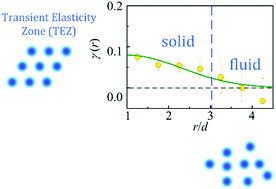Local elasticity in nonlinear rheology of interacting colloidal glasses revealed by neutron scattering and rheometry†
Abstract
The flow of colloidal suspensions is ubiquitous in nature and industry. Colloidal suspensions exhibit a wide range of rheological behavior, which should be closely related to the microscopic structure of the systems. With in situ small-angle neutron scattering complemented by rheological measurements, we investigated the deformation behavior of a charge-stabilized colloidal glass at particle level undergoing steady shear. A short-lived, localized elastic response at particle level, termed as the transient elasticity zone (TEZ), was identified from the neutron spectra. The existence of the TEZ, which could be promoted by the electrostatic interparticle potential, is a signature of deformation heterogeneity: the body of fluids under shear behaves like an elastic solid within the spatial range of the TEZ but like fluid outside the TEZ. The size of the TEZ shrinks as the shear rate increases in the shear thinning region, which shows that the shear thinning is accompanied by a diminishing deformation heterogeneity. More interestingly, the TEZ is found to be the structural unit that provides the resistance to the imposed shear, as evidenced by the quantitative agreement between the local elastic stress sustained by the TEZ and the macroscopic stress from rheological measurements at low and moderate shear rates. Our findings provide an understanding on the nonlinear rheology of interacting colloidal glasses from a micro-mechanical view.

- This article is part of the themed collection: 2018 PCCP HOT Articles


 Please wait while we load your content...
Please wait while we load your content...
